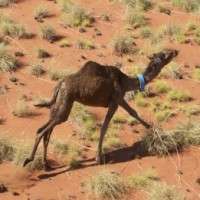Camels betray their best mates in 'Judas' trials

Murdoch University researchers have successfully trialled an approach to control feral camel numbers in Australia's outback whereby a single animal is used to betray the whereabouts of its companions.
The technique relies on the social nature of the invasive species – in this case, the dromedary camel – which number around one million in remote areas of arid central Australia.
The camels threaten biodiversity, agriculture and biosecurity in these regions but controlling their numbers in remote areas is expensive and logistically challenging, said research leader, Associate Professor Peter Spencer from the School of Veterinary and Life Sciences at Murdoch.
"An understanding of the social structure of invasive species like camels is needed for management programs to be effective," he said.
"The Judas technique relies upon the target species exhibiting sufficient flexibility in their social structure for monitored individuals to detect, and be accepted by multiple animal cohorts. Basically, a single tracked individual does all the hard work by finding other groups of camels that would normally be very difficult to locate.
"It has been shown in previous trials to be a highly effective method for controlling gregarious invasive species like feral goats.
"The technique involves putting telemetry collars onto animals and periodically tracking them to cull the cohort of companion animals that the individual has joined. The technique is particularly effective when pest animals are found at medium to low densities or are widely dispersed in remote areas."
Utilising technology identical to that used in forensic investigations, the DNA-profiling data collected from 1,050 camels was used to characterise the genetic diversity and relatedness within and between observed social groups. Professor Spencer and his team of researchers found the camel groups were not defined by relatedness meaning they had a social structure that would be conducive to applying the Judas technique.
This discovery runs contrary to the prevailing opinion that camel groups were dictated by familial relationships, such as with elephants where groups comprise principally of females and their genetically-related offspring.
Professor Spencer's research team also performed an operational trial of the Judas technique to assess the predictions of the genetic data. Ten camels were collared and tracked for periods of time across two years. Judas camels were found with other animals on 96 per cent of occasions.
The groups found with the collared camel showed no significant size difference before and after culling took place, Professor Spencer said. And because they are so wide ranging when seeking a new group to join, the collared camel could continue to prove useful even if all local populations of the animal have been eradicated.
While an effective method for controlling the animals where population densities are low, Dr Spencer admitted that it was still expensive and he recommended it be used in conjunction with other control methods.
The full details of Professor Spencer et al's research were recently published in The Journal of Wildlife Management. Their paper is entitled "Genetic relationships within social groups influence the application of the Judas technique: A case study with wild dromedary camels".
The dromedary camel occupies 37 per cent of the Australian continent.
They were imported into Australia from Arabia, India and Afghanistan during the 19th century for transport and construction during the colonisation of the central and western parts of Australia.
Many were released into the wild after motorised transport replaced the camels' role in the early 20th century.
More information: Spencer, P. B.S., Hampton, J. O., Pacioni, C., Kennedy, M. S., Saalfeld, K., Rose, K. and Woolnough, A. P. (2015), "Genetic relationships within social groups influence the application of the Judas technique: A case study with wild dromedary camels." Journal of Wildlife Management, 79: 102–111. doi: 10.1002/jwmg.807
Journal information: Journal of Wildlife Management
Provided by Murdoch University



















